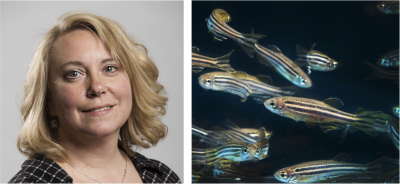Przejdź do trybu offline z Player FM !
Ep 18. Why Do We Care About Emerging Contaminants?
Manage episode 308842560 series 3021653
As the Director of the Great Lakes Genomics Center in the School of Freshwater Sciences at the University of Wisconsin-Milwaukee, Professor Rebecca Klaper researches emerging contaminants such as nanomaterials and pharmaceuticals and how they affect freshwater organisms. In this episode we interview Dr. Klaper about the future of emerging contaminants and how her work relates to the development of sustainable nanomaterials.

(L: Rebecca Klaper is the Director of the Great Lakes Genomics Center in the School of Freshwater Sciences at the University of Wisconsin-Milwaukee. R: Zebrafish are often used in toxicology research (image from Oregon State University.)
Want more podcast episodes? You can find them all on our podcast page, or you can subscribe on iTunes or Stitcher.
#### **ABOUT THIS EPISODE**
Related links:
- Professor Rebecca Klaper
- EPA Scientist Weighs Emerging Contaminants
- About the National Exposure Research Laboratory (NERL)
- Environmental Defense Fund
- Our Stolen Future
- Using Gene Expression to Learn About Nanoparticle Toxicity
- Center for Sustainable Nanotechnology
Interviewee: Professor Rebecca Klaper
Interviewers: Natalie Hudson-Smith and Jaya Borgatta
Producer/Host: Miriam Krause
Music: Ketsa
50 odcinków
Manage episode 308842560 series 3021653
As the Director of the Great Lakes Genomics Center in the School of Freshwater Sciences at the University of Wisconsin-Milwaukee, Professor Rebecca Klaper researches emerging contaminants such as nanomaterials and pharmaceuticals and how they affect freshwater organisms. In this episode we interview Dr. Klaper about the future of emerging contaminants and how her work relates to the development of sustainable nanomaterials.

(L: Rebecca Klaper is the Director of the Great Lakes Genomics Center in the School of Freshwater Sciences at the University of Wisconsin-Milwaukee. R: Zebrafish are often used in toxicology research (image from Oregon State University.)
Want more podcast episodes? You can find them all on our podcast page, or you can subscribe on iTunes or Stitcher.
#### **ABOUT THIS EPISODE**
Related links:
- Professor Rebecca Klaper
- EPA Scientist Weighs Emerging Contaminants
- About the National Exposure Research Laboratory (NERL)
- Environmental Defense Fund
- Our Stolen Future
- Using Gene Expression to Learn About Nanoparticle Toxicity
- Center for Sustainable Nanotechnology
Interviewee: Professor Rebecca Klaper
Interviewers: Natalie Hudson-Smith and Jaya Borgatta
Producer/Host: Miriam Krause
Music: Ketsa
50 odcinków
Wszystkie odcinki
×Zapraszamy w Player FM
Odtwarzacz FM skanuje sieć w poszukiwaniu wysokiej jakości podcastów, abyś mógł się nią cieszyć już teraz. To najlepsza aplikacja do podcastów, działająca na Androidzie, iPhonie i Internecie. Zarejestruj się, aby zsynchronizować subskrypcje na różnych urządzeniach.




